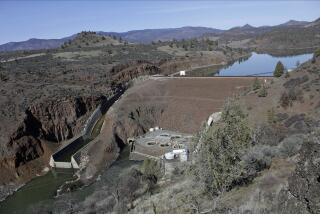Big dam, bigger problems
- Share via
Right now, the Obama administration is participating in its first annual meeting of the African Development Bank, which is mandated to fund critical infrastructure for poor African nations. On the agenda is financing one of the biggest projects ever considered by the bank, the $2.1-billion Gilgel Gibe III dam in Ethiopia.
The U.S. government has contributed more than $400 million in the last three years to the African Development Bank. It is also Ethiopia’s largest aid donor, giving upward of $450 million a year for everything from food and water to military assistance. American taxpayers have a responsibility to ensure that this money is well spent.
By any measure, Gibe III is a lousy investment. It is the third element in a massive five-part dam project on the Omo River and its tributaries. The Ethiopian government wants to generate power, in part for export, by “taming” the Omo. But this is the most poorly planned hydropower project being built on the continent today. The government has cut corners in its preparation, increasing its risks of economic and technical failure, and it has done next to nothing to reduce the project’s massive ecological and social footprint. A group of affected people and the organization I work for, International Rivers, already have filed complaints with the African Development Bank, citing five social and environmental bank policies the dam violates.
Gibe III will change forever the Lower Omo River Valley, one of the world’s most isolated regions. It is the homeland of a handful of indigenous communities, half a million farmers, herders and fishermen who are largely untouched by modern society. Damming the Omo will wreak havoc with its natural flood cycles, which underlie the cultures and the traditional “flood retreat” farming practices of the Mursi, Bodi, Kara and other communities along it.
The dam will affect ecosystems and disrupt communities all the way to the world’s largest desert lake, Turkana, downstream in Kenya. An oasis of biodiversity in a harsh desert, Lake Turkana, a World Heritage site, supports more than a quarter of a million Kenyans and rich animal life. The Omo River accounts for up to 90% of the lake’s inflow. That will be curtailed by at least 50% as the dam fills, and it will be reduced thereafter by evaporation from the massive reservoir that will form behind the dam, according to the African Resources Working Group, which is made up of international scientists and scholars who work in Ethiopia. Turkana’s salinity -- already high -- will intensify, making it undrinkable and affecting fisheries.
Such outcomes should have been predicted in project analysis, but Ethiopia started building the dam before undertaking a thorough environmental impact assessment. When it finally produced such a report, the project was already two years into construction and the study, again according to the independent African Resources Working Group, was “fundamentally flawed.” Ethiopian government officials told the BBC that proper environmental studies were simply “luxurious preconditions.”
The people who depend directly on the Omo’s precious water would have appreciated having the dam’s sweeping effects on their lives properly analyzed before the bulldozers rolled out. International Rivers’ studies show that only a tiny proportion of the people have been consulted or effectively informed of the changes the dam will bring, in contravention of guarantees in the Ethiopian Constitution.
For centuries, these unique cultures tied to a harsh landscape have proved highly resilient, but the dam, combined with climate change, may prove to be the last straw. These communities need small-scale water supply systems where they live, increased capacity to grow food crops during times of drought and other forms of climate-adaptation assistance. Big, centralized dams will not address these needs.
Climate change brings huge risks not just for riverine people and biodiversity but for the dam’s viability as a development project. Five major droughts since 1980 already have taken a toll on Ethiopia’s economy. More than 85% of its electricity now comes from large dams; the figure will be 95% after the dam boom is over. A drought-crippled Gibe III would bring a sea of red ink to Ethiopia and lead to blackouts and economic consequences for regional governments that buy its electricity.
The African Development Bank should closely investigate Gibe III and measure it against the bank’s environmental and social standards. Rather than support such destructive projects, it should help Ethiopia drought-proof its energy sector, diversify its energy mix, tap its abundant renewable energy resources and get serious about climate-change adaptation plans for its river peoples. That is what the United States government should be supporting at the bank this week, not the Gibe III dam.
More to Read
Sign up for Essential California
The most important California stories and recommendations in your inbox every morning.
You may occasionally receive promotional content from the Los Angeles Times.













